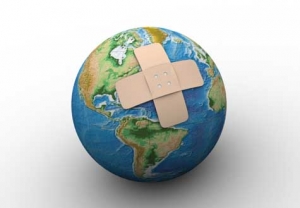The weekly report on the academic research and demographic polls of secularism,
by Dr. Greg Neimeyer, SPI Fellow
 Should scientists begin to intervene to counter the earth’s climate change, or back off and let nature take its course? These topics were at the heart of a recent report on climate change interventions where experts were asking themselves the “fix it or nix it” question; should scientists meddle with Mother Nature to combat global warming, or should they leave her alone and let nature takes its course instead. After reviewing the issues and available strategies, the consensus of the report, produced by the National Research Council that advises the federal government, was to “wait and see” at this time, in part because many of the innovative strategies for climate intervention may not be ready for prime time at the moment.
Should scientists begin to intervene to counter the earth’s climate change, or back off and let nature take its course? These topics were at the heart of a recent report on climate change interventions where experts were asking themselves the “fix it or nix it” question; should scientists meddle with Mother Nature to combat global warming, or should they leave her alone and let nature takes its course instead. After reviewing the issues and available strategies, the consensus of the report, produced by the National Research Council that advises the federal government, was to “wait and see” at this time, in part because many of the innovative strategies for climate intervention may not be ready for prime time at the moment.
But that doesn’t mean that science should sit idly by argues Waleed Abdalati of the University of Colorado in Boulder, a coauthor of the reports. Instead, scientists should redouble their efforts to explore and perfect intervention options so that they are ready to deploy them in the event that things continue to deteriorate at an accelerating pace.
Current schemes to manually manipulate the planet’s temperature may read like the plot of a Jules Verne novel, but they nonetheless merit exploration and, if need be, intervention in the years ahead. Among the principle plans are two different strategies to dodge the destructive impact of global warming. One is to effectively vacuum vast volumes of planet-warming carbon dioxide directly out of the air and pump it deep underground for storage. The second is to shield the earth from the sun’s scorching rays by reflecting them back into space. For this method, researchers have examined the possibility of spraying tiny particles into the atmosphere that might reflect the warming radiation. This approach might mimic volcanic eruptions, which are known to have wide-scale cooling effects on the planet. Other ideas might include generating synthetic cloud cover and deploying this periodically to cool the planet and regulate its climate.
Of course, no one knows the extent to which these strategies might work, the precision with which we might control the “earth’s “thermostat,” or the nature of the downstream implications associated with their implementation. Massive cloud cover, for example, could register a significant impact on crop production and weather patterns. And, of course, both methods would only represent “band aid” solutions; as soon as we stopped siphoning off gases and diverting them to underground storage, or pumping the sky full of solar-reflecting cloud cover, the earth would begin warming again without, moreover, fully understanding the consequences of this man-made cycle of cooling and warming on the planets’ various life forms.
But research into even the most fanciful of these ideas needs to continue, says Abdalati. A co-author of the reports, Abdalati argues that humans may one day find themselves in a climate emergency when the risks of doing nothing outweigh the risks of an intervention, making it prudent to examine those risks now so that more informed decisions can be made then, if the need should arise. If things ever get really bad, we don’t want to find ourselves in the earliest stage of experimentation, notes international relations specialist David Victor of the University of California, San Diego. The Council’s recommendation to keep pursuing research is an important step toward developing those global back-up plans.
Citations
Climate intervention: Carbon dioxide removal and reliable sequestration (2015), Committee on Geoengineering Climate: Technical Evaluation and Discussion of Impacts; Board on Atmospheric Sciences and Climate; Ocean Studies Board; Division on Earth and Life Studies; National Research Council, Published February 10, 2015.
Climate intervention: Reflecting sunlight to cool Earth (2015), Committee on Geoengineering Climate: Technical Evaluation and Discussion of Impacts; Board on Atmospheric Sciences and Climate; Ocean Studies Board; Division on Earth and Life Studies; National Research Council, Published February 10, 2015.
